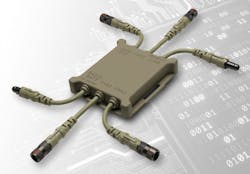Army picks Elbit to design wearable data and power networking device for battlefield infantry warfighters
ABERDEEN PROVING GROUND, Md. – U.S. Army land warfare experts needed data and power distribution for wearable devices to minimize complexity, and to reduce parts counts, size, weight, cost (SWaP-C). They found their solution from Elbit Systems of America in Fort Worth, Texas.
Officials of the Army Contracting Command at Aberdeen Proving Ground, Md., announced a $25.1 million contract to Elbit on Thursday for the Next Generation Hub (NGH).
This wearable data- and power-distribution system is part of the Army's Nett Warrior program, a soldier-worn system for infantry combat leaders. Nett Warrior provides computer processing, data storage, user display, and navigation while operating as the Universal Serial Bus (USB) host.
The Next Generation Hub facilitates data exchange between the Nett Warrior user device and other peripherals, and also provides power distribution from a common power source. It bridges devices like wearable computers, tactical radios, and conformal batteries.
Related: Military wearable computing hits the mainstream
The Next Generation Hub functions as a USB 2.0 hub for data communication among devices. It also distributes power from two power input ports to provide network power to connected devices.
This wearable data and power networking device will measure between 3 and 3.5 inches long, between 2 and 4 inches wide, and between 0.4 and 0.75 inches deep, including sockets, plugs, and connectors. It will weigh between 5 and 8.5 ounces.
Elbit engineers will design the Next Generation Hub to be balanced to avoid causing an uneven weight distribution on infantry warfighters. Users will be able to adjust its position to tailor the load distribution, or to add equipment.
The device will have connector protection from dirt and debris with a replaceable tethered cover when not in use. It will have standard Army camouflage, and will distribute thermal energy to minimize its thermal signature.
The Next Generation Hub shall incorporate six military circular connections for battery input; radio and battery input; device receptacles; and host receptacle with sockets.
The Next Generation Hub will have an integrated intra-soldier wireless capability, with an AES-256 bit encrypted wireless data connection for a personal area network that works with other warfighters no farther apart than two meters. It also will have DCTC-1 TEMPEST for electronic security.
The Next Generation Hub will have cyber security protection against enemy software attacks on its internal and externally networked systems, and will not accept in-field software and firmware updates unless its source is authenticated.
The device will work without a user visible display or status indicators beyond a multi-color LED or LEDs, and will not have user input devices like keyboards. It will draw no more than 1 Watt of power when connected to a power source with no other devices connected.
Users will be able to identify position location by feel in darkness, and plug and unplug cables and connectors in the dark. Its cabling and connectors will be able to withstand 10-pound loads without breaking, and its pigtail connectors will be able to bend as far as 180 degrees.
The Next Generation Hub will work at altitudes from sea level to 32,000 feet, and will operate in temperatures from -18 to 49 degrees Celsius. It will work in hot humid conditions with humidity as high as 95 percent, and can survive immersion in one meter of water for as long as 30 minutes. It also will work in a salt fog atmosphere.
The device will resist the effects of shock, vibration, sand, dust, rain, water, fungus, and electromagnetic interference.
On this contract Elbit will do the work in locations to be determined with each order, and should be finished by January 2028. For more information contact Elbit Systems of America online at www.elbitamerica.com, or the Army Contracting Command-Aberdeen at https://acc.army.mil/contractingcenters/acc-apg/.
About the Author
John Keller
Editor-in-Chief
John Keller is the Editor-in-Chief, Military & Aerospace Electronics Magazine--provides extensive coverage and analysis of enabling electronics and optoelectronic technologies in military, space and commercial aviation applications. John has been a member of the Military & Aerospace Electronics staff since 1989 and chief editor since 1995.
